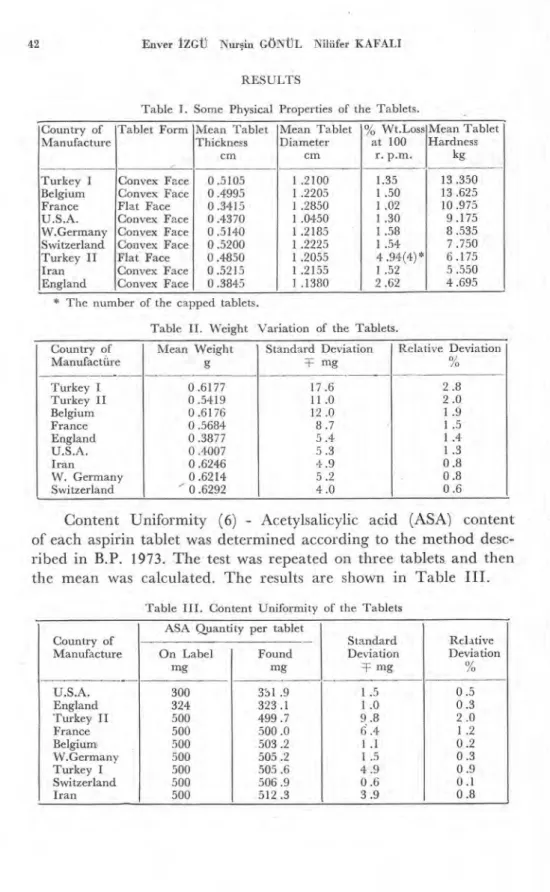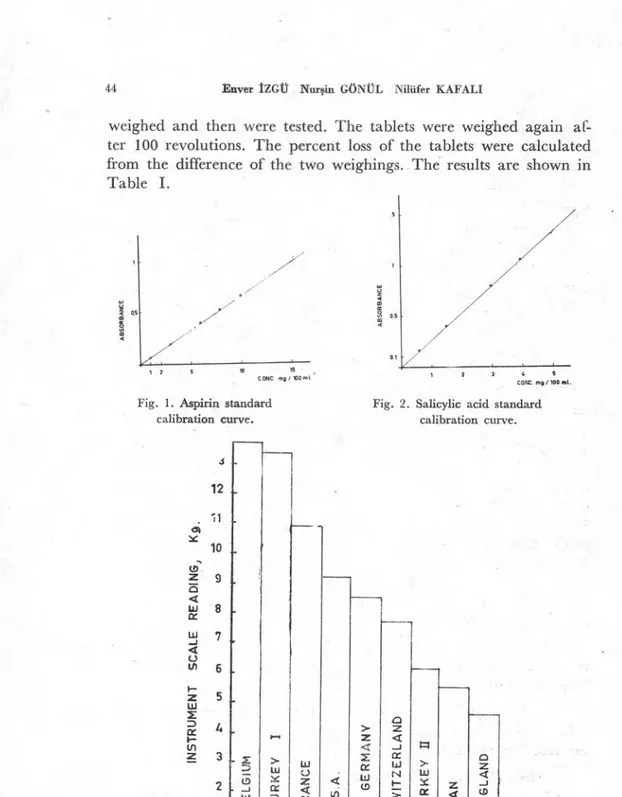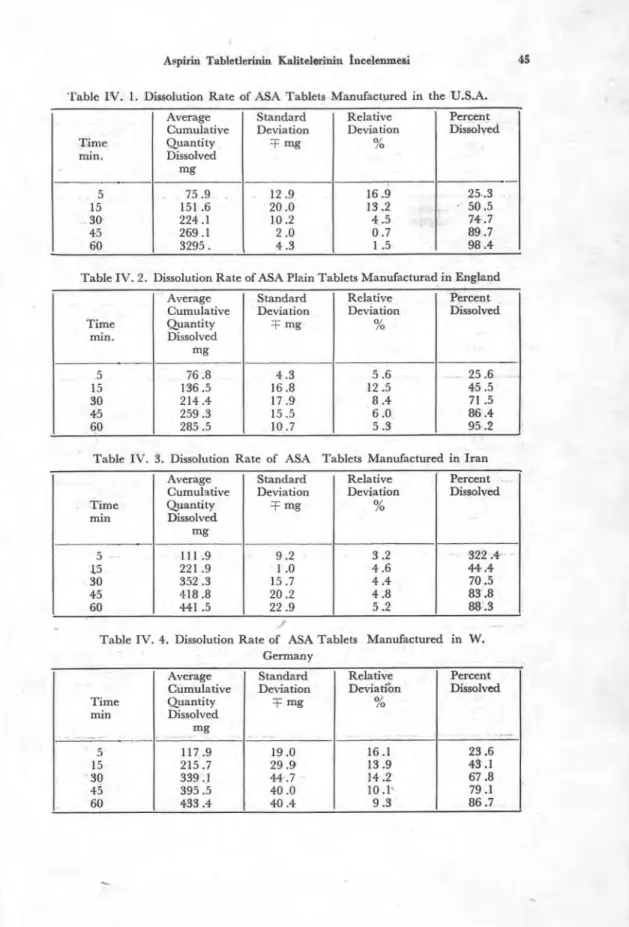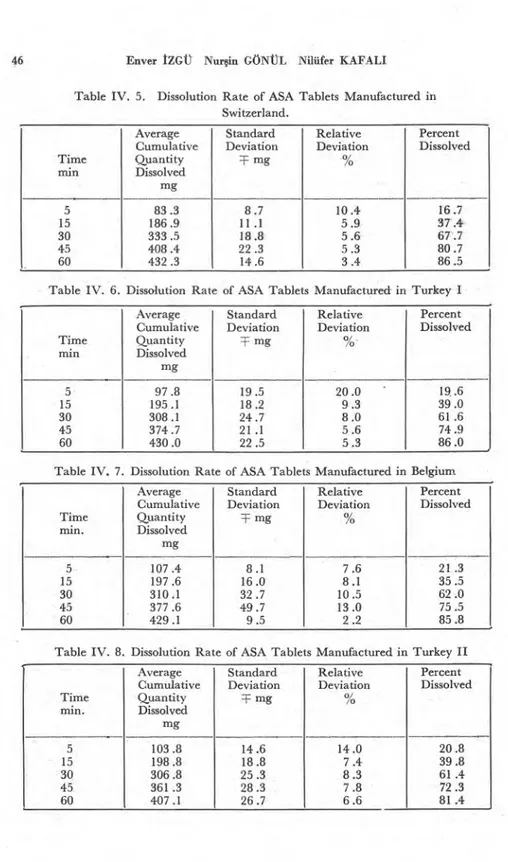Ankara Ecz. Fak. Mec. J. Fac. Pharm Ankara
6. 39 (1976) 6. 39 (1976)
Investigation on the Quality of Aspirin Tablets Manufactured in Different Countries, by Applying The Methods Used in Pharmaceutical Technology
Çeşitli Ülkelerde Imal Edilmiş Aspirin Tabletlerinin Farmasötik Teknolojide Kullanılan Yöntemler ile
Kalitelerinin Incelenmesi
Enver İZGÜ*, Nurşin GÖNÜL*, Nilüfer KAFAM*
Aspirin has analgesic, antipyretic and anti-inflammatory actions and it is used for the relief of the less severe types of pain such as hea-dache, neuralgia, neuritis, rheumatic joint pains, myaligas and in the treatment of acute and chronic rheumatic states.
Because of its easy availability, cheapness, low toxicity and the less side effects, it is the most commonly used of all analgesics (1, 2, 3, 4). It is reported that serious gastric effects and side effects as tinnutus and sensitivity are observed in patients who have been using aspirin for a long time. The mechanism of bleeding in gastrointestinal tract after administration of an aspirin tablet is quite complicated. The more often occurance of bleeding and erosion after administration of an aspirin tablet, observed in gastrointestinal tract in patients, who have low pH, are attributed to the stomach HC1. Even with the analgesic doses, aspirin inhibits the platelet function in the body and extends the bleeding time (2, 3, 5).
It is suggested that aspirin with milk and food reduces the irri-tating effect. Since it may cause metabolictic diseffects, aspirin is not recommanded for children below 1 year of age (1). Adults can take 0.3 to 1.0 g. and up to 4.0 g. daily. In the treatment of acute rheumatism, this can be increased even to 8.0 g. daily, in divided doses (6). In horses and cows 25 to 50 g., in sheep and pigs 1.0 to
Redaksiyona verildiği tarih: 19. Ocak. 1976.
* Farmakognozi ve Galenik Farmasi Kürsüsü, Eczacılık Fakültesi, Ankara Ünive sitesi.
40 Enver IZGI.). Nurşin GÖNÜL Nilüfer KAFALI
3.0 g., in dogs 0.25 to 1.0 g. and in cats 0.1 to 0.2 g. dosages are used ( 3)•
Tablet form is the most used dosage form of aspirin among the other dosage forms of aspirin such as aspirin suppository and aspirin capsule.
Aspirin is the first recommended medicine in the case of indis-positions in our country and also in many other countries. Presently, people can get aspirin tablets from any drugstore or grocer's without a prescription and know how to use it. However, he takes certain means for avoiding its side effects. For example, foreign aspirin tab-lets are usually preferred to domestic product. Because, it is believed to have less side effects. This causes domestic aspirin tablets to be cheaply available compared to expensive availability of foreign as-pirin tablets.
43 persons were asked whether they preferred domestic or foreign aspirin tablets, and their reasons for preference. Most of the people who answered, were professional pharmacists and graduate students of pharmacy. 22 of them preferred domestic aspirin tablets, while the remaining 21 preferred foreign aspirin tablets.
The reasons of the preference for domestic aspirin tablets were contribution to domestic industry, the fact that domestic aspirin tab-lets have the same effect and prevent the unnecessary foreign currency payment. Those, who preferred foreign aspirin tablets, indicated that it might have been manufactured with better production tech-niques and better quality controls and as a result those factors cau-sed better effects.
The question of "Which aspirin tablet is better?" and "Is the preference due to psychological reasons or is it because of better technology and hence better quality?" may be arised. These ques-tions led us to make the present study.
In this study, the quality control methods, used in pharmaceu-tical technology, were applied to domestic and foreign aspirin tab-lets, and the results based on the experimental data. The results were compared with each other and with the limits stated in the pharma-copoeias, which were accepted as reference in this study.
Aspirin Tabletlerinin Kalitelerinin incelenmesi 41
EXPERIMENTAL MATERIAL and METHODS
In tablet technology, appearance, porosity, color stability, strength (hardness, friability, fracture resistance, bending strength, and crushing strength), weight variation, content unifor-mity, disintegration time and dissolution rate (7, 8) are the most important factors used both during production steps and quality controls. Appropriate test methods, based on the above factors, are used (6,. 9, 10, 11, 12, 13, 15) and the qualities of the tablets are de-termined according to the results.
Aspirin (ASA) tablets, used in the experiments, were obtained from Switzerland, W. Germany, England, France, Belgium, the
U.S.A., Iran, and Turkey 1. Among different types of aspirin tablets, like effervescent, buffered, sustained release and plain, only the last one was chosen to be tested.
The following test methods were conducted on the tablets ac-cording to the U.S.P. XVIII and B.P. 1973. Since, U.S.P. XVIII gives the description of the quality control methods comprehensively, it is chosen a basic pharmacopoeia for our experiments in this study. B.P. 1973 was chosen as a second basic pharmacopoeia, because, some of the methods described there, are easy to be applied. Howe-ver, the procedure and the limits of the hardness and friability tests for tablets do not appear in the pharmacopoeias, we performed tests according to the literature (16), and we compared the results with each other.
Thickness and Size of the Tablets (6) - The thickness and the diameter of the tablets were measured with a ca.11ipers I on the ten tablets of aspirin, manufactured in the above countries. The metin values are shown in Table I.
Weight Variation of the Tablets (13) - The weights of twenty tablets of each country were determined according to the method described in the U.S.P. XVIII. The results are shown in Table II.
1 Turkey I and Turkey II represent the plain tablets of two different manufactories in Turkey.
42 Enver İZGÜ Nursin GÖNÜL Nilüfer KAFALİ
Table I. Some Physica• Properties of the Tablets. Country of
Manufacture
Tablet Form Mean Tablet Thickness cm Mean Tablet Diameter cm % Wt.Loss at 100 r. p.m. Mean Tablet Hardness kg Turkey I Convex Face 0.5105 1 .2100 1.35 13.350 Belgium Convex Face 0.4995 1 .2205 1 .50 13.625 France Flat Face 0.3415 1 .2850 1 .02 10 .975 U.S.A. Convex Face 0.4370 1 .0450 1 .30 9.175 W.Germany Convex Face 0.5140 1 .2185 1 .58 8.535 Switzerland Convex Face 0.5200 1 .2225 1 .54 7 .750 Turkey II Flat Face 0.4850 1 .2055 4 .94(4)* 6.175 Iran Convex Face 0.5215 1 .2155 1 .52 5 .550 England Convex Face 0.3845 1 .1380 2 .62 4 .695
* The number of the capped tablets.
Table II. Weight Variation of the Tablets. Country of Manufact&e Mean Weight g Standard Deviation T- mg Relative Deviation % Turkey I 0.6177 CO c0 I cv C V C ş C ş Turkey II 0.5419 Belgium 0.6176 France 0.5684 England 0.3877 U.S.A. 0.4007 Iran 0.6246 W. Germany 0.6214 Switzerland ' 0.6292
Content Uniformity (6) - Acetylsalicylic acid (ASA) content of each aspirin tablet was determined according to the method desc-ribed in B.P. 1973. The test was repeated on three tablets and then the mean was calculated. The results are shown in Table III.
Table III. Content Uniformity of the Tablets
Country of Manufacture
ASA Quantıty per tablet
Standard Deviation T mg Relative Deviation % On Label mg Found mg U.S.A. 300 331.9
-1 ° R : CD c v C ş CD England 324 323.1 Turkey II 500 499.7 France 500 500 .0 Belgium, 500 503 .2 W.Germany 500 505 .2 Turkey I 500 505 .6 Switzerland 500 506 .9 Iran 500 512.3Aspirin Tabletlerinin Kalitelerinin Incelenmesi 43
Salicylic acid Content (6) - The tests for comparison of salicylic acid (SA) were performed according to the B.P. 1973. The color of the solutions prepared from the tablets, were compared with the color of the standard solutions. The colors of the English and Turkish I samples were darker than the color of the standard solution.
Disintegration Test (13) - Disintegration times were determined with a disintegration tester ı according to the conditions specified in the U.S.P. XVIII. The tablets, manufactured in England, in Turkey I, in W. Germany, in Switzerland, in the U.S.A., in Iran, in Turkey II, in France, and in Belgium, disintegrated in 8, 9, 5,
13, 14, 15, 15, 15, 19 and 22.5 seconds respectively.
Dissolution Rate (13) - Dissolution rate of ASA tablets were determined with a dissolution rate testert according to the U.S.P. rotating basket method. The dissolution medium consisted of 900 ml of 0.1 N HC1. The test was conducted at 55 r.p.m., and at 37 T 0.5 °C. Although for ASA tablets, the agitation intensity correspon-ding to the in vivo dissolution rate, is suggested to be 55 T10 r.p.m. (17), the experiments were conducted at 50 r.p.m. Because the Er-weka Dissolution Rate Tester could not be set to 55 r.p.m. The ab-sorbance of the samples, which were taken from the medium at 5,
15, 30, 45, and 60 minutes, were measured with a spectrophotome-ter t at 276 nm for ASA, and 303 nm for SA. The amonut of ASA and SA containad in each sample were calculated from the concentration versus absorbance plots (Fig. 2 and Fig. 3) The test was repeated on three tablets of each colıntry and the mean was calculated. The results are shown in Tables IV. 1 - IV. 9.
Hardness of the Tablets (16) - Hardness of the tablets were de-termined with a hardness tester ı according to the literature (16). The results are shown in Table I and in Fig. 3.
Friability (16) - Friability of the tablets were determined with a friabilatori with a speed of 27-28 r.p.m., according to the method described in the literature (16). Ten tablets of each country were
'Disintegration Tester, Erweka, Type ZT 2.
5Ultraviolet Spectrophotometer, Pye Unicam SP 1700, Unicam Instruments
Limi-ted, Cambridge.
6Monsanto Hardness Tester, Monsanto Chemicals, St. Louis 4, Missouri.
44 Enver IZGI)" Nurşin GÖNÜL Nilüfer KAFALI
weighed and then were tested. The tablets were weighed again at= ter 100 revolutions. The percent loss of the tablets were calculated from the difference of the two weighings. The results are shown in Table I.
Fig. 1. Aspirin standard calibration curve.
Fig. 2. Salicylic acid standard calibration curve. z WI TZE RLAN D TU RK E Y II 0 z
Aspirin Tahletlerirtin Kalitelerinin incelenmesi 45
Table IV. 1. Dissolution Rate of ASA Tablets Manufactured in the U.S.A. Average Cumulative Standard Deviation Relative Deviation Percent Dissolved Time min. Quantity Dissolved mg T mg % 5 75.9 12.9 16.9 25.3 15 151.6 20.0 13.2 - 50.5 30 224.1 10.2 4.5 74.7 45 269.1 2.0 0.7 89.7 60 3295. 4.3 1.5 98.4
Table IV. 2. Dissolution Rate of ASA Plain Tablets Manufacturad in England Average Cumulative Standard Deviation Relative Deviation Percent Dissolved Time min. Quantity Dissolved mg T mg % 5 76.8 4.3 5.6 25.6 15 136.5 16.8 12.5 45.5 30 214.4 17.9 8.4 71.5 45 259.3 15.5 6.0 86.4 60 285.5 10.7 5.3 95.2
Table IV. 3. Dissolution Rate of ASA Tablets Manufactured in Iran Average Cumulative Standard Deviation Relative Deviation Percent Dissolved Time min Quantity Dissolved mg T mg % 5 111.9 9.2 3.2 322.4 15 221.9 1.0 4.6 44.4 30 352.3 15.7 4.4 70.5 45 418.8 20.2 4.8 83.8 60 441.5 22.9 5.2 88.3
Table IV. 4. Dissolution Rate of ASA Tablets Manufactured in W. Germany Average Cumulative Standard Deviation Relative Deviatihn Percent Dissolved Time min Quantity Dissolved mg R= mg % 5 117.9 19.0 16.1 23.6 15 215.7 29.9 13.9 43.1 30 339.1 44.7 14.2 67.8 45 395.5 40.0 10.1' 79.1 60 433.4 40.4 9.3 86.7
46 Enver IZGÜ Nurşin GÖNÜL Nilüfer KAFALI
Table IV. 5. Dissolution Rate of ASA Tablets Manufactured in Switzerland. Average Cumulative Standard Deviation Relative Deviation Percent Dissolved Time min Quantity Dissolved mg T mg % 5 83.3 8.7 10.4 16.7 15 186.9 11.1 5.9 37.4 30 333.5 18.8 5.6 67.7 45 408.4 22.3 5.3 80.7 60 432.3 14.6 3.4 86.5
Table IV. 6. Dissolution Rate of ASA Tablets Manufactured in Turkey I Average Cumulative Standard Deviation Relative Deviation Percent Dissolved Time min Quantity Dissolved mg T mg % 5 97.8 19.5 20.0 19.6 15 195.1 18.2 9.3 39.0 30 308.1 24.7 8.0 61.6 45 374.7 21.1 5.6 74.9 60 430.0 22.5 5.3 86.0
Table IV. 7. Dissolution Ra e of ASA Tablets Manufactured in Belgium Average Cumulative Standard Deviation Relative Deviation Percent Dissolved Time min. Quantity Dissolved mg T mg % 5 107.4 8.1 7.6 21.3 15 197.6 16.0 8.1 35.5 30 310.1 32.7 10.5 62.0 45 377.6 49.7 13.0 75.5 60 429.1 9.5 2.2 85.8
Table IV. 8. Dissolution Rate of ASA Tablets Manufactured in Turkey II Average Cumulative Standard Deviation Relative Deviation Percent Dissolved Time min. Quantity Dissolved mg T mg % 5 103.8 14.6 14.0 20.8 15 198.8 18.8 7.4 39.8 30 306.8 25.3 8.3 61.4 45 361.3 28.3 7.8 72.3 60 407.1 26.7 6.6 81.4
Aspirin Tabletlerinin Kalitelerinin Incelenmesi 47
Table IV. 9. Dissolution Rate of ASA Tablets Manufactured in France Time min. Average Cumulative Quantity Dissolved mg Standard Deviation T mg Relative Deviation % Percent Dissolved 5 77.4 9.7 12.6 15.5 15 164.7 18.2 11.0 32.9 30 289.2 20.4 7 .0 57.8 45 366.3 10.9 4.3 73.3 60 405.7 4.3 1.1 81.1 DISCUSSION
Results obtained from the experiments are shown in Tables I, II, III, and IV.
It is natural that an aspirin tablet, manufactured in a country, has to conform to its own pharmacopoeia. But we needed a compe-tent reference in order to compare all the properties of the tablets in detail. Therefore we accepted the U.S.P. XVIII as the basic refe-rence, since it contains almost all of the test methods and test limits extensively. We used B.P. 1973 as a second reference. Because some of the test methods described there, were simplier than the methods stated in the U.S.P. XVIII.
Considering that the sizes of the tablets containing 500 mg and 300 mg ASA have to be within 5 % limit of 12.5 mm and 10.5 mm respectively (6), when the results in Table 1 are observed, it can be accepted that, except for the English aspirin all of the tablets were within the limits specified by the U.S.P. XVIII.
The results of the weight variation of the tablets are observed in Table II, indicated that all of them were within the accepted li-mits, when the limits are set as 5 % of mean weight for the tablets heavier than 324 mg (6, 13). However, the greatest deviation was observed on the tablets manufactured in Turkey I, while the devia-tion was smallest for the tablets manufactured in Switzerland.
The test results of ASA content of the tablets, shown in Table III, indicated that the tablets manufactured in the U.S.A. have amounts greater than the limit, while all of the other tablets are wit-hin the T 5 % limit of the amount stated on the label (11).
PERC EN T D iSSOL VED
48 Enver İZGİi. Nurşin GÖNÜL Nilüfer KAFALİ
Considering the results both of SA content and dissolution rate of the tablets, it can be said that all of the tablets, except the tablets manufactured in England and in Turkey I, were in compliance with the pharmacopoeia (6).
The disintegration time for all the tablets tested, was less than the 5 minutes limit stated in the pharmacopoeia (13).
Data obtained from the dissolution rate tests of the tablets for the U.S.A., England, Iran, Germany, Switzerland, Turkey I, Bel-gium, Turkey II, and France are shown in Tables IV. 1 to IV. 9, and in Figures 4 and, 5, respectively.
15 30 45 GO
TİME mis
ıG.4,.Curnulatıve percent dıssolved from Aspirin plan tablets ma.
nufactureJ in the U.SA ( wıENGLAND , in IRAN
), in W. GERMANY ( 4, in SWİTZERLAND (... ..): in
TURKEY I (— tn BELGIUM in TURKEY —
3.0
2.5
/
0.5
0.0
Aspirin Tabletlerinin Kalitelerinin incelenmesi 49
15 30 45 GO
Tİ min.
Fig. S _ Cumutative percent of Salicytic acid dissolved from Aspirin pla'm
tablets nıonufactured in the U.S A (—); in ENGLAND IRAN
in W. GERMANY (---), in SWITZERLAND L—) in TURKEY
50 Enver IZGÜ Nurşin GÖNÜL Nilüfer KAFALI
The percentage of ASA dissolved from the tablets were calcu-lated as 15-30, 30-50, 55-85, 70-90, and 80-100 in 5, 15, 30, 45, and 60 minutes respectively.
According to the plots shown in Fig. 4, it can be said that per-cent dissolved of aspirin from the tablets manufactured in the U.S.A. and in England, were higher than the other countries.
According to the results of the hardness test shown in Table I, the values were quite different from each other. The tablets manu-factured in England had the lowest value for hardness, while the tablets manufactured in Belgium were the hardest.
Friability test results, shown in Table 1, indicated that the tab-lets manufactured in Turkey II are the least resistive tabtab-lets. The tablets manufactured in England follow these. The rest of the tablets have quite close friability results.
Generally, it can be said that the domestic ASA tablets, in ge-neral showed in compliance with the pharmacopoeias in the quality control tests as with the foreign aspirin tablets. However, the results of the dissolution rate tests, which have a mean about the biological effects _of the drug, indicated that the tablets manufactured in Tur-key, followed the other countries.
These outcomes implied that aspirin tablets manufactured in the U.S.A. probably had technological superiority over the other aspirin tablets tested. However, it has to be stated that this imp-ression was the results of the tests conducted on the plain tab-lets of aspirin which were randomly collected from the market. On the other hand, the quality of the aspirin tablets on the market depends largely on the technical facilites of the laboratories and fac-tories manufacturing the aspirin tablets, and on the knowledge and experience of the personnel.
SUMMARY
Aspirin has analgesic, antipyretic and anti-inflammatory ac-tions and it is used as the first recommended drug in the case of in-dispositions in our country and in many other countries.
The question of "Which aspirin tablet would you prefer, a do-mestic one or the one produced abroad?" was asked to forty-three
Aspirin Tabletlerinin Kabtelerinin İneelanmesi 51
people. Most of them were professional pharmacist and graduate students of pharmacy. Twenty-two of them preferred domestic aspi-rin tablets, while the remaining twenty-one preferred foreign aspiaspi-rin tablets.
The question of "Which aspirin tablet is better?" might be arised. The preference can be due to psychological reasons or due to better technology and hence better quality.
In the present study, we investigated the qualities of the plain tablets of aspirin manufactured in different countries to answer the above question experimentally.
The quality control methods used in pharmaceutical technology were applied to the plain tablets of aspirin which were obtained ran-domly from the markets in Turkey, in Iran, in Germany, in Belgium, in Switzerland, in France, in the U.S.A. and in England. The met-hods applied, were, the determination of size and thickness, hard-ness, friability, weight variation, content uniformity, salicylic acid content, disintegration time, and dissolution rate of the tablets.
The results obtained from experiments were compared with the limits in pharmacopoeias and with each other.
The results indicated that the plain tablets of aspirin manufac-tured both in Turkey and in the other countries, were generally in compliance with the pharmacopoeias. The aspirin tablets, produced in the U.S.A. seemed to be more conformable to the limits stated in pharmacopoeias.
ÖZET
Analjezik, antipiretik ve antienflamatuvar olarak etkiyen as-pirin, ülkemizde ve diğer birçok ülkelerde rahatsızlık hallerinde ilk akla gelen ve çok kullanılan bir ilaçtır.
Yerli ve yabancı ülkelerde imal edilmiş aspirin tabletlerden han-gisini ve niçin tercih ettikleri hakkında kırküç kişi üzerinde bir an-. ket yapıldı. Anketi cevaphyanlarm büyük bir kısmını asistan eczacı -lar ve eczane eczacıları oluşturuyordu. Anket sonucunda yirmi-ikisinin yerli, geriye kalan yirmi bir kişinin de yabancı kaynaklı As-pirin tableti tercih etmekte oldukları ortaya çıktı.
52 Enver IZGIY Nurşin GÖNÜL Nilüfer KAFALI
Acaba hangi tabletler daha iyiydi? Tercih nedenleri psikolojik sebeplere mi yoksa teknolojik üstünlükten ileri gelen daha iyi bir kalite farkına mı dayanıyordu?
İşte bu soruları deneysel olarak cevaplıyabilmek için yaptığımız bu çalışmada, çeşitli ülkelerde imal edilmiş basit aspirin tabletlerin kalitelerini belirlemeye ve elde edilen bulgulardan sonucu saptama-ya çalıştık.
Türkiye, Iran, Almanya, Belçika, İsviçre, Fransa, İngiltere ve Amerika Birleşik Devletleri piyasalarından sağlanan basit aspirin tabletler üzerinde farmasötik teknolojide kullanılan kalite kontrol yöntemleri uygulandı. Tabletler üzerinde başlıca, büyüklük ve ka-lınlık, sertlik, aşınma, ufalanma, ağırlık dağılımı, içerdiği etken mad-de miktarı, içerdiği salisilik asit miktarı, dağılma süresi ve çözünür-lük hızı tayinleri yapıldı.
Yapılan deneylerden elde edilen bulgular birbirleriyle ve far-makope limitleriyle kıyaslandı.
Bulgular, Türkiye'de imal edilmiş aspirin tabletlerin diğer ül-kelerin aspirin tabletleri ile birlikte genellikle farmakopelere uygun olduğu kanısını uyandırdı. Ancak A.B.D. aspirin tabletlerinin diğer ülkelerin aspirin tabletlerine kıyasla farmakope limitlerine daha ya-kın olduğu izlenimi bıraktı.
REFERENCES
1 . Extra Pharmacopoeia (Martindale), 25 th Ed., The Pharmaceutical Press, Lon-don (1967).
2 . Martin, E.W., Cook, E.F. -Remington's Practise of Pharmacy 20 th Ed., Mack Pub-lishing Co., Easton, Pennyslvania 1082-1083, (1961).
3 . The Merck Index, 8 th Ed., Merckand Co., Inc., Rahway, N.J., U.13, S.A., (1968). 4. Izgü, E., Farmasötik Bilimler Ankara Derneği, Bülteni, 1, 2, 8, 9, (1974).
5. Goth, A., -Medical Pharmacology, 7 th Ed., The C.V. Mosby Comp. U.S.A. 331 (1974).
6 . British Pharmacopoeia (B.P.1973), University Printing House, Camridge 37, A 131-133, (1973).
7. Brook, D.B., Marshall, K., J.Pharm.S i. 57, 3, 481-483 (1968).
8 . Bean, H.S., Beckett, A.H., Carless, J.E., -Advances in Pharmacutical Sciences Academic Press, London, New York 3,4-5, (1971).
Aspirin Tabletlerinin Kalitelerinin incelenmesi 53
9 . Izgü, E., -Genel ve Endüstriyel Farmasi II, Ayyıldız Matbaası, A.Ş., Ankara 225-230, (1974).
10. Güven, C.K., -Farmasi ve Teknolojisi, Hüsnütabiat Matbaası, İstanbul 266-269, (1972).
11 . Türk Farmakopesi 1974, Milli Eğitim Basımevi 176-177, (1974).
12 . Lachman, L., Lieberman, H.A., Kanig, J.L. -The Theory and Practice of
Indust-rial Pharmacy, Lea and Febiger, Philadelphia 265, 332-336, (1970).
13 . The United Pharmacopoeia (U.S.P. XVIII), 18 th Rey. Mack Printing Co., Eas-ton, 54, 930-934, 951, (1970).
14 . The National Formulary, 13 th Ed., Mack Printing Co., Easton 802-803, 878-879, 902, (1970).
15. Deutsches Arneibuch, 7. Ausgabe, Deutscher Apotheker Verlag, Stuttgart 43-44, (1968).
16. Seitz, J.A., Flessland, G.M., J.Pharm.Sci., 54, 1353-1354 (1965). 17. Levy, G., Leonards, J.R., Procnal, J.A., ibid., 56, 365 (1967).




